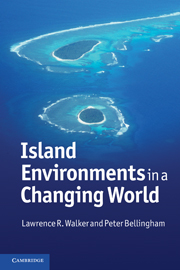Book contents
- Frontmatter
- Contents
- Preface
- Photo credits
- 1 Introduction to island environments and cultures
- 2 The physical setting
- 3 Natural disturbances on islands
- 4 The plants and animals of islands
- 5 Human dispersal, colonization, and early environmental impacts
- 6 Intensifying human impacts on islands
- 7 Islands in the modern world, 1950–2000
- 8 The future of island ecosystems: remoteness lost
- Glossary
- Index
- Plate section
- References
7 - Islands in the modern world, 1950–2000
Published online by Cambridge University Press: 05 June 2012
- Frontmatter
- Contents
- Preface
- Photo credits
- 1 Introduction to island environments and cultures
- 2 The physical setting
- 3 Natural disturbances on islands
- 4 The plants and animals of islands
- 5 Human dispersal, colonization, and early environmental impacts
- 6 Intensifying human impacts on islands
- 7 Islands in the modern world, 1950–2000
- 8 The future of island ecosystems: remoteness lost
- Glossary
- Index
- Plate section
- References
Summary
INTRODUCTION
In this chapter, we explore the environmental consequences of human habitation on the nine island groups during the period from approximately 1950 to 2000. We also examine the reciprocal impacts of those islands' environments on human activities. The loss of life during World War II served to reset many national priorities and the second half of the twentieth century became a time of great technological development, wealth creation, and population growth. On the whole, this half-century was one of optimism. Advances in technology permitted more intensive and extensive exploitation of fisheries, agricultural land, mines, and military reservations. Each of these advances had its own ecological consequences. Wealth brought leisure and rapid expansion of recreational hunting and tourism to islands, again with significant impacts on the native flora and fauna as well as on natural resources such as clean water and air. Ample energy and resources, improved transportation, plus optimism about the future led to fast growth of human populations and the concentration of people in urban areas on many islands. However, for some more remote islands, the advent of rapid transport led to population decline as people moved to urban areas elsewhere. These advances in technology and increased human control over the environment led to a rapid transition from native-dominated ecosystems to those that are a mix of native and introduced species and to some that are largely created by humans.
- Type
- Chapter
- Information
- Island Environments in a Changing World , pp. 235 - 292Publisher: Cambridge University PressPrint publication year: 2011

